
Any business that works with third-party vendors opens itself up to new risks that could expose them to costly claims and lawsuits. Tracking the details of contractors’ insurance coverage is a crucial element of any company’s risk management strategy.
How can you ensure that your vendors and subcontractors are insured? What is a certificate of insurance, or COI, and when does your company need one? Where do you even begin with a certificate of insurance tracking?!
When it comes to managing risks when working with vendors, contractors, subcontractors, and other third parties, having a clear understanding of certificates of liability insurance is crucial.
Navigate the realm of COIs with confidence with our latest guide. In this article, we will explore the key aspects of liability COIs, including what they are, how to request one, and their importance in various scenarios.
If you’re asking these questions and more, follow along in our new guide for some certificate of insurance 101, where we’ll outline everything you need to know about COIs and answer frequently asked questions in the space.
What Is a COI?
A COI is a document issued by an insurance company to give evidence of a vendor’s insurance coverage. A certificate of liability insurance aims to give evidence of specifically their liability coverage, which provides protection for things like bodily injury and property damage.
Liability insurance certificates, like other COIs, outline a policyholder’s insurance details, such as policy limits, effective dates, and any needed endorsements. The document demonstrates that an insured party has liability coverage in place, protecting themselves and the businesses they work with in the case of accidents, property damage, or other unforeseen incidents.
How Do I Ask for a COI?
Getting vendor certificate of insurance requests out the door can be challenging, but it’s essential to do it in order to verify their coverage. And typically, the earlier, the better.
Thankfully, requesting a certificate of insurance from a potential vendor is typically not a complex process. Here’s how to get a certificate of liability insurance from relevant third parties:
- Clearly communicate your requirements. Start by informing the contractor or vendor that you need a certificate of liability insurance from them as part of your contractual agreement. Specify the minimum coverage types, policy limits, and any additional insured endorsements you require so they know exactly what they need to tell their insurer.
- Wait for them to deliver the COI. Part of the insurance certificate requesting process lies with the vendor themselves, who has to go to their insurer (in person or via an online portal), provide relevant information, and request the document. They’ll typically get it after a few business days and send it straight to you.
- Verify adequate coverage. Once you receive a vendor certificate of insurance, review it to ensure that it meets your specified requirements. Confirm that all details are correct and that the coverage types, policy limits, and effective dates align with the level of risk associated with the project or services provided.
When Do You Need a Certificate of Insurance from a Vendor?
Think of it like this: you want your vendors and third parties to be covered from the moment they walk onto your job until the moment they complete it. The most reliable and standard way to verify this information is through COI collection and verification.
Essentially, you need a certificate of insurance for vendors or subcontractors whenever they provide services or work on your behalf. This is crucial to protect your business from potential liability arising from their actions.
Whether it’s construction work, maintenance services, product delivery, or other specific service work, requesting a COI ensures that any vendor you want to work with has the necessary insurance coverage to mitigate risks associated with their work.
To summarize: you need a COI from any third party you work with, and you should get it from them before they begin said work.
Is a Certificate of Liability Insurance the Same as a Declaration Page?
Some people wonder about the difference between COIs and declaration pages, but to put it simply: no, a certificate of liability insurance is not the same as a declaration page.
A declaration page is an internal document issued to a policyholder by their insurance company that provides a summary of policy details, including coverage types, policy limits, deductibles, and endorsements.
A COI, on the other hand, is a document issued to a policyholder at their request by their insurance company as proof of insurance coverage, typically to be distributed externally to hiring parties like you. It includes policyholder information, coverage details, and any needed additional insured endorsements.
Is a Certificate of Insurance the Same as an Insurance Policy from an Insurance Company?
Certificates of insurance are distinct from insurance policies. You can think of an insurance policy as a purchase (because it is—you are purchasing protection in exchange for monthly premiums) and a corresponding COI as a receipt. COIs provide proof that someone had an active insurance policy at the time the certificate was generated, and effectively summarize that lengthy documentation into a succinct and easily digestible document. Insurance certificates include key policy details such as the named insured’s information, a brief description of their operations, policy details, the limits of liability, a cancellation notice, and the certificate holder’s (a.k.a. requesting party’s) contact information.
What Are Certificates of Insurance Used for?
Certificates of insurance are used for several important purposes:
- Risk management. COIs, especially liability COIs, help manage risks associated with contractor or vendor services by ensuring they have adequate insurance coverage. This protects your business from potential liabilities arising from accidents, property damage, and other related incidents.
- Compliance. Many industries and contracts have specific insurance requirements in place. COIs help ensure compliance with these obligations, helping your business avoid penalties and breaches of contract.
- Proof of insurance. COIs provide tangible evidence that vendors have valid liability insurance coverage. This proof is often required by clients, project owners, or regulatory entities to ensure the third party is adequately insured.
How Do I Get an Insurance Certificate
To get an insurance certificate, you first need to contact your insurance provider or insurance agent. They can generate the certificate (COI) for you. All you have to do is give them details such as your insurance type and policy number. Your insurance provider should then be able to process your request and issue a certificate to you. This can be done electronically or can be sent by regular mail.
It is important to review your COI to make sure all of the information is accurate and up-to-date. This can become time-consuming if you’re managing multiple COIs, which is where myCOI can come in.
What Is a COI as It Pertains to Insurance Coverage?
A COI is a document that certifies the existence and details of an insurance policy. COIs are significant documents in the insurance space; businesses use them for the important purpose of verifying vendors’ insurance coverage status. They clearly detail the insurance carrier, coverage limits, effective and expiration dates, and more. Let’s go over some commonly asked questions about COIs so that you can have a better understanding of what they are, when they’re needed, and by whom.
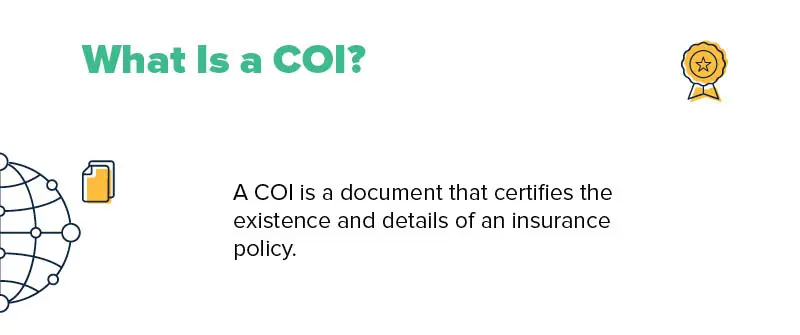
Who Gets a COI?
Anyone working as a contractor or doing business with third-party service providers should know about COIs, as they will probably have to deal with them at some point. Typically, a hiring party of a vendor will request a COI from them, and the contractor will work with their insurance provider to generate one, then provide it to the hiring business to verify that it is valid and meets their needs for the job.
Why Would a Business Request a Certificate of Insurance for Liability Insurance?
It is critical that any business that hires contractors, vendors, or third-party service providers of any kind follow the best practice of requesting a certificate of insurance from each new third party that they hire. This is largely because there can be serious and costly legal ramifications for not doing so. By requiring a hired third party’s proof of insurance, you can verify that they have adequate coverage in place to mitigate risks associated with accidents, property damage, or other unforeseen events that could happen on the job. It is the due diligence of a hiring party to make sure that those you hire are correctly covered and contractually compliant for a job—and if they aren’t, they’re unnecessarily exposing you to a host of underinsured claims, lawsuits, and fines.
How Can You Verify a COI?
Once you have a vendor’s COI in hand, you should verify that it a) is valid, b) represents the requested kind of insurance coverage for the correct individual, and c) meets your vendor COI requirements. To ensure a COI’s validity, you can confirm that the insurance company listed is legitimate, check that all boxes are correctly filled in, and compare their COI to downloadable PDF templates available online. Also, make sure that the name at the top of the COI represents the contractor you want to verify coverage for. Finally, validate that it meets the requirements that you laid out for them. (If the contractor is honest and correctly worked with their insurance provider to obtain the COI, this should all be golden, but almost 70% of the time, it isn’t. That’s why this whole process is so critical!)
How Long Should a COI Be Kept?
You should absolutely keep your vendors’ COIs on hand even after their policy expires. It is a good rule of thumb to keep COIs in your files for five years after working with someone, just in case of a future claim coming up. Digital COI management can be helpful in maintaining all of these files in an organized, centralized, and environmentally friendly fashion. Later, we’ll go over the importance of COI tracking, the practice of managing incoming COIs, and ensuring that your vendors are covered throughout the duration of your business partnership.
What Is an Additional Insured on a COI?
A common question that comes up with COIs relates to additional insureds. An additional insured endorsement is essentially an addition to an insurance policy, extending one’s coverage to a new party that doesn’t have to pay for it. This typically goes down as follows: a business hiring a contractor doesn’t just want to know that the contractor has insurance but wants that coverage to extend to them as well. So, they’ll request that the contractor list them as an additional insured (at a small additional cost to the contractor) so that they are also covered by the policy in the case that they suffer damages during the course of working together.
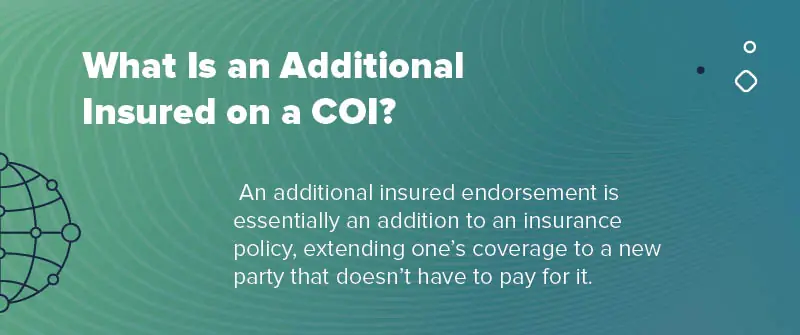
How to Get a Certificate of Insurance?
Now that we’ve covered some of the basics about what a COI is and who uses it in business, let’s elaborate on how actually to get a COI in the USA. The process can sound a little confusing because both a business and a vendor technically “request” a COI, but really it’s rather simple. Here’s how a business gets a COI for a vendor in order to verify their coverage:
- A smart and ethical business wanting to work with a third-party vendor will outline their requirements for that vendor’s insurance (e.g., proof of liability coverage up to $250,000 for the timespan of November 2023–November 2024).
- The business will send over these vendor requirements in the form of an official COI request, which can be sent in multiple ways but is these days typically delivered via email.
- The honest and compliant vendor will go to their insurance provider, who is providing the policy in question, with the COI request. Their insurer will verify that their coverage meets the businesses’ requirements or work to modify the policy so that it does.
- The vendor’s insurance provider will generate the COI (they are the only party able to do so!). They will return the COI to the vendor to provide to the hiring business or deliver it directly to the business itself.
How Can Vendors Request COIs?
When a vendor is hired for a job, or sometimes before they are even hired for a job, the business taking them on will submit a request for a COI from them in order to confirm that they have adequate insurance coverage. To request a COI for the coverage that the business needs proof of, a vendor will turn to their insurance provider. They can either call, book an appointment, or use an online insurance portal in order to contact their insurer. From there, the insurer does most of the work in generating and issuing the actual COI—they are, in fact, the only ones who can do so.
How to Get a COI for a Business?
On the hiring side of things, businesses will follow the aforementioned steps of deciding upon their COI vendor requirements, outlining them in an official COI request letter, and submitting the request to the vendor(s) in question. Upon receipt of the certificate, savvy businesses will know that the work is not yet done. Verifying that the COI came from a reputable insurance provider, that the information is accurate, and that the policy meets their needs is also a duty of the hiring business. From there, they should keep the COI in their records, as well as communicate to the vendor(s) that they need to renew their policy ahead of its expiration in order to continue working on a project to ensure that there are no lapses in coverage.
How to Get a Certificate of Insurance for an Event?
Often, when running an event, it’s a good idea to acquire event COIs from all vendors that will be present or to purchase special event insurance that can protect you from third-party claims of non-employee bodily injury, property damage, and personal and advertising injury that occur during it. Following the same logic as the above scenarios, if you are the one needing to obtain a COI to prove your own coverage, you can work with your insurance provider to do so, or if you want to get a COI from vendors that will be at your event to prove their coverage, you will submit a request to each of them to do so.
Can I Issue my Own Certificate of Insurance Online?
You can absolutely not, under any circumstance, issue your own certificate of insurance online. While COI templates exist online at the website of the creator of the standardized COI forms we all know and love today (ACORD, which we’ll cover shortly), they should never be used in the place of valid certificates. Again, only insurance providers—the insurance provider supplying the in-need-of-proof coverage for a vendor—can issue an official and valid certificate of insurance.
What Is a Certificate of Insurance ACORD?
ACORD, which stands for the Association for Cooperative Operations Research and Development, is an important organization in the insurance space. Established as a nonprofit in 1970, ACORD started as a group of insurance agents that came together to create more efficiency across the industry. Today, they are most well-known for issuing and archiving standardized insurance forms like certificates of insurance, which can all be found on their website. They have also developed a comprehensive library of electronic data standards with over 1200 standardized transaction types to support the ease of exchange of insurance data between practitioners and partners.
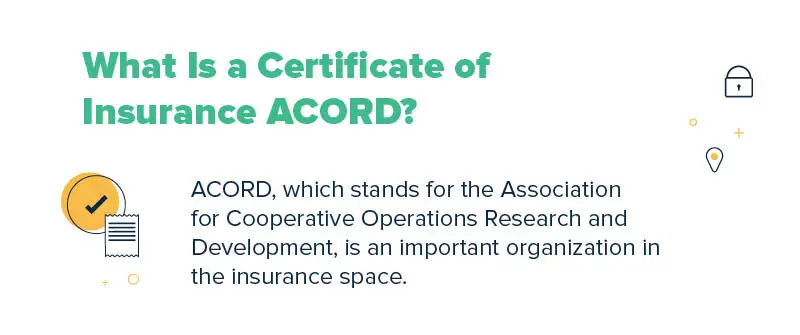
What Are the Types of COIs?
Because there are various types of insurance policies, ACORD offers various types of COIs. Each looks slightly different depending on the specific policy that they are providing evidence of coverage for. The existence of different types of COIs helps streamline the process of both providing and receiving evidence of coverage for various kinds of insurance. To access example, ACORD forms online, you can peruse the ACORD forms portal.
What Is an ACORD 25 Used For?
The ACORD 25 form, the Certificate of Liability Insurance, is one of the most common COI forms and is widely recognized in the insurance industry. It serves as the standard COI for certifying general liability insurance.
What Is ACORD 23 Used For?
The ACORD 23 form, the Vehicle or Equipment Certificate of Insurance, provides information about vehicle or equipment insurance in the case of any damage for leased and financed vehicles.
What Is an ACORD 27 Used For?
The ACORD 27 form, the Evidence of Property Insurance, is used to represent proof of personal property insurance coverage and is commonly requested by parties such as mortgagees or those interested in renting or buying a residential property.
What Is ACORD 75 Used For?
The ACORD 75 form, or Insurance Binder, is not actually a certificate of insurance. It acts as a temporary contract that verifies insurance coverage in advance of the issuance of an actual policy (when one is intended to be purchased). ACORD 75 forms are short-term documents, and the issuance of a corresponding insurance policy will void them.
How Do You Track COIs?
In this guide, we’ve talked a lot about the different kinds of COIs, and how and why businesses get them. However, as we’ve mentioned, receiving a COI is not the last step in the COI management process—verification is required for each certificate you receive, and you should have a process in place for their storage. Here is what the COI tracking process should generally look like:
- Collection: Collect COIs from every vendor, contractor, subcontractor, and third party that your business works with before they begin a job. It is helpful to establish a company-wide collection system with guidelines for your specific requirements for hired parties.
- Storage: Keep all COIs in a secure location or a centralized software system. These documents should stay well-named and organized for easy access and maintenance.
- Verification: Ensure the validity of the COI and be certain that vendors’ policies meet the insurance requirements your company has laid out for them.
- Correction (when necessary): If any information on the certificate does not meet your requirements or makes the COI noncompliant, contact the contractor or their insurer to update the policy as needed.
- Maintenance: It’s important to keep track of vendor COIs, especially since policies expire and vendors can switch insurers. Follow up with your contractors to ensure that you have the correct information on file or to remind them to renew their insurance to avoid a lapse in coverage so that they maintain compliance.
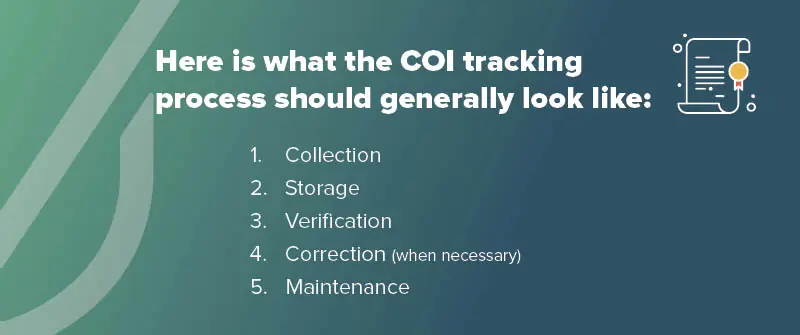
Why Do You Need to Track COIs?
As we’ve mentioned, collecting COIs from hired third parties is helpful to a business for multiple reasons. Firstly, they help businesses ensure that their hired vendors are compliant with contractual insurance requirements, industry-wide standards, and state regulations. COI collection also makes claims adjustment processes easier in the event that damages or losses occur on a job. Ultimately, COI tracking helps protect businesses against millions of dollars in potential damage claims filed each year.
What Makes a Good COI Tracking Process?
A sophisticated COI tracking system can be difficult to establish and maintain, but it’s crucial to do your best to create one that works well for your business. A good COI tracking process is one that keeps your company and the contractors you work with protected from unnecessary claims, transferring loss to third-party insurers in cases where things go wrong. Some other good qualities of a COI tracking process include creating standards for collection and verification, keeping an ample documentation trail for each certificate, and allowing for regular reviews for continual improvement.
What Are the Most Common Issues in COI Tracking?
Tracking COIs is an important, detail-oriented, and time-consuming process. It is often a repetitive effort, but one that’s important to get right every time. One common issue that comes up in COI tracking is that manual data entry is naturally prone to human error. Another is that businesses, especially those with smaller teams, are usually not insurance experts trained in compliance management. Risk analysis can be difficult, and more so if a team is not well-trained in the nitty-gritty of how to ensure that your business is adequately protected.
Is it Okay to Track COIs In-house?
Many businesses, especially small ones, track their COIs in-house, which simply means that they collect, verify, and store vendor COIs manually. While this is a totally doable process, and some of our blogs offer assistance for doing so, many companies have trouble keeping up with COI tracking and management, especially as their hiring scales. Typically, in-house COI management means lots of man hours, stacks of paper documents, and (understandable) human error. For that reason, smart businesses turn to professional COI tracking services, such as myCOI, to streamline their COI management.
What Is the Best Way to Track COIs?
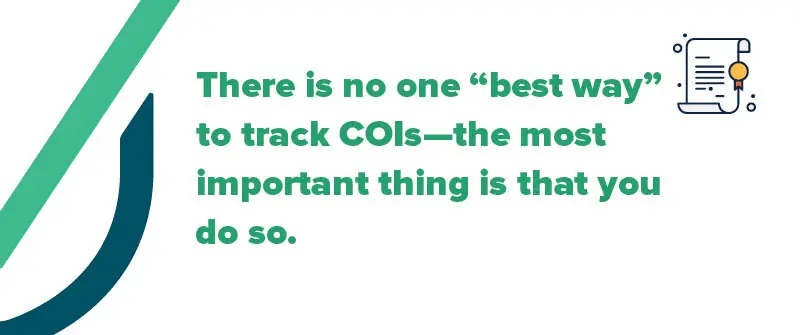
There is no one “best way” to track COIs—the most important thing is that you do so. However, the process is simplified and streamlined by working with sophisticated COI management software and service providers like myCOI. COI management tools offer some major benefits, such as these:
- COI services allow for the efficient gathering and reviewing of insurance information, making for better overall risk assessment for your company.
- While COI software typically has a cost associated with it, it provides major savings in the form of risk mitigation, fewer claims, and overall efficiency, as well as how the streamlining of laborious tasks frees up your team’s time for other work.
- COI management teams, like the in-house experts at myCOI, help ensure that compliance issues don’t slip through the cracks by carefully reviewing certificates and confirming that primary and non-contributory, waiver of subrogation, additional insured on completed operations, and other critical requirements are met every time.
Why Is myCOI the Best COI Tracking And Management Provider?
Whether you’re worrying about your business’s insurance compliance or dreading the stack of certificates of insurance waiting to be reviewed and entered into your system, myCOI has the technology and the expertise to make certificate of insurance tracking easier. And unlike anyone else in the industry—we provide a warranty against the decisions we recommend.
Contact us today if you’d like to know what it’s like to work with the best COI software on the market, either with the Essentials or Concierge package.